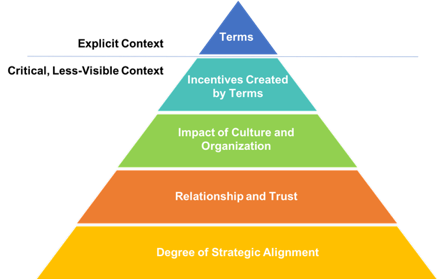As a business leader you get 360s, so why doesn’t the business you lead?
Individually, you benefit from 360s exposing blind spots and unintended consequences of your “default” way-of-being. Your company has blind spots and default ways-of-being, too…and they undermine the success of critical relationships with outsourcing providers, product and channel partners, and anchor customers – the vital “360” space around your company.
Are partners “nickel and diming” you? Do you worry their best people aren’t on your account? Are quality or speed issues cropping up? Do you wish they’d invest more in innovation or expansion?
These are symptoms of a misaligned partnership with low self-awareness on one or both sides. That’s where the value of an “Enterprise 360” comes in, helping you achieve stable, co-prosperous relationships rather than the drama- and disappointment-filled ones that are all too common.
Imagine the value you can unlock if you deeply understand where a relationship is today, clearly see the forces affecting it and have a concrete plan to realize the thriving partnership you envisioned when you signed the deal.
With this as your why, let’s consider what characterizes strong relationships and then discuss how to move in this direction with an Enterprise 360 approach.
Dimensions of Thriving, Co-Prosperous Relationships
You know that motivating and managing your people is only partially about financial incentives. Shared purpose, values and culture, behavioral norms and a sense of long-term opportunity are also incredibly important.
Holistic Success Dimensions for High-Stakes, High-Complexity Partnerships

Let’s take a holistic look at the deeper less-visible dimensions—beyond the limited impact of financial/legal terms—that drive success in highly-complex partnerships.
Incentives Created by Terms
As a business executive, you feel economic pressure, which feeds the instinct to “win” a negotiation. Your partner faces similar pressure, but in response, it may willingly enter into an arrangement even when the economics squeeze its ability to acceptably perform. This is “the paradox of the willing partner.” Sometimes, the other side just needs that deal this quarter or that revenue this year, or to keep its factory or workforce utilized. And even when you have an initially-fair and balanced deal, it can easily be knocked out of balance by changing market conditions.
That’s why the landscape is full of partnerships that are bad for one side. But over time, what’s bad for one side is bad for both. Imagine a landscaper you don’t pay quite enough, so he hurries on to the next job and doesn’t clean up thoroughly in your yard. It’s you who steps on the rake.
You may object: “But suppliers, partners and customers always say they deserve more of the financial pie within your relationship. I can’t always respond to this. That’s business.” That’s an understandable and fair point – and a good Enterprise 360 approach helps determine when there is a real wolf, or the other side is just crying wolf.
Impact of Culture and Organization
Your business culture and the way you’re organized impact the partnership, too.
For example, do you have a culture of invention or operational precision? These strong suits probably helped get you where you are today. But they may also make you overly prescriptive in third-party relationships. Maybe you’re not just telling them what you need…you’re telling them how. Many partnerships exist specifically because the other side has expertise and capabilities you don’t – so over-prescriptiveness limits your upside.
Maybe your structure burdens partners, too. Think of a contract manufacturer with a global customer organized around regional P&Ls, for instance. If all territories are involved in managing outsourcing, then supplier personnel do everything three times (with the Americas, EMEA and Asia Pacific). Wondering why your key contact isn’t getting to the root cause of that issue or helping drive innovation? Maybe it’s because she’s doing everything – calls, email and reports – in triplicate…or maybe she can’t get a timely straight answer when she needs one from you because there’s no clear process owner on your side.
You may say, “But culture or organizationally-driven issues are not 100% under my control.” While this is certainly true, unless you’re the CEO – where relationship outcomes are critical – it’s not a good enough excuse. The question becomes: how will you lead and influence inside your company? An Enterprise 360 provides powerful data here.
Relationship and Trust
Even if you ensure incentives are aligned and you are aware of the impact your culture and organization have on partners…problems periodically arise.
To deal with them, is there an authentic and empathic relationship between partner company executives and, based on that tone-setting, between the working teams? Only this type of relationship supports a shared view of current reality and a productive “shared contribution” approach (instead of blame) to problem solving.
And is there mutual trust – in each other’s capabilities, reliability and motivation?
Authenticity, empathy and trust may sound “soft,” but imagine if they were absent within your company. Wouldn’t cross-functional problem-solving and pursuit of new opportunities be severely hamstrung? That’s not to say these things are easy, but inside your company there are (hopefully) degrees of flexibility, resilience and improvisation based on the presumption of good will and capability among colleagues – and the willingness to act accordingly.
Just because you rely on a third-party, these qualities are not any less important. In fact, they may be even more critical. That’s why your Enterprise 360 approach should listen for this dimension with equal emphasis as the others.
Degree of Strategic Alignment
What if your strategy and your partner’s create different views on what’s worth investing in, what’s worth bending on and what the future looks like? Sometimes, even when everything else is going well, this is a hidden inhibitor.
Imagine a corporate tech reseller/integrator and an enterprise software company whose solutions it distributes. Economic incentives may be aligned, culturally- and organizationally-driven inefficiencies may be under control, and relationships may be strong. But if the software company’s strategy is to increase emphasis on direct sales and become part of solution suites with “platform” partners (de-emphasizing reseller-type channel partners), then a growing headwind will affect the partnership.
That’s why it’s critical to keep using Enterprise 360-style listening not just to gain self-awareness, but also to assess the ongoing fit with partners. Without this, you’re implicitly counting on your partners’ strategic priorities to remain frozen in a world where nothing lasts forever.
Enterprise 360 for Deep Systemic Listening Across These Dimensions
OK. If all this motivates you to gain broader perspective on how your company shows up in critical third-party relationships, here are suggested next steps.
- Invest time and energy to get a clear baseline understanding of where relationships are today. I’m not talking about a “conducting a survey.” To get what you want here, you need thoughtful and customized 1:1 discussions with partner executives, account leaders and operational people.
- Prioritize bringing your internal stakeholders together to get oriented around what you’ve learned, what the implications are and what your options are for action where that’s warranted. Often, the first key step is to get aligned on the fact that your partnership success relies on the dimensions discussed here.
- Develop or update your guiding vision for the partnership. What will a long-term, excellent relationship feel like and deliver – and what’s your company’s part in achieving it? This step isn’t always about positive aspirations…an effective process sometimes leads to purposefully de-emphasizing or ending relationships, too.
- Make aligned action plans to target the things that “must be true” for achievement of the vision. These could include evolution on any/all of the dimensions detailed above. Since there are often collective blind spots and deeply-ingrained ways-of-being at work here, treat this as a concerted transformation effort.
Often, for high-complexity, high-stakes relationships, you’ll get the most out of this Enterprise 360 approach by using an objective third party to engage with partners and facilitate your company’s orientation and action-planning around what you’ve learned. Find one who understands your business andthe critical human/partnership dimensions in play, and who has the ability to credibly engage and draw out relationship-sponsoring executives and key day-to-day relationship managers alike.
Remember that individual 360 we started off referring to? If you’ve gone through that process, you know it can be uncomfortable…but you also understand that the information you get from it is invaluable. With an Enterprise 360 effort, you can lead that same powerful learning and growth for your company.






